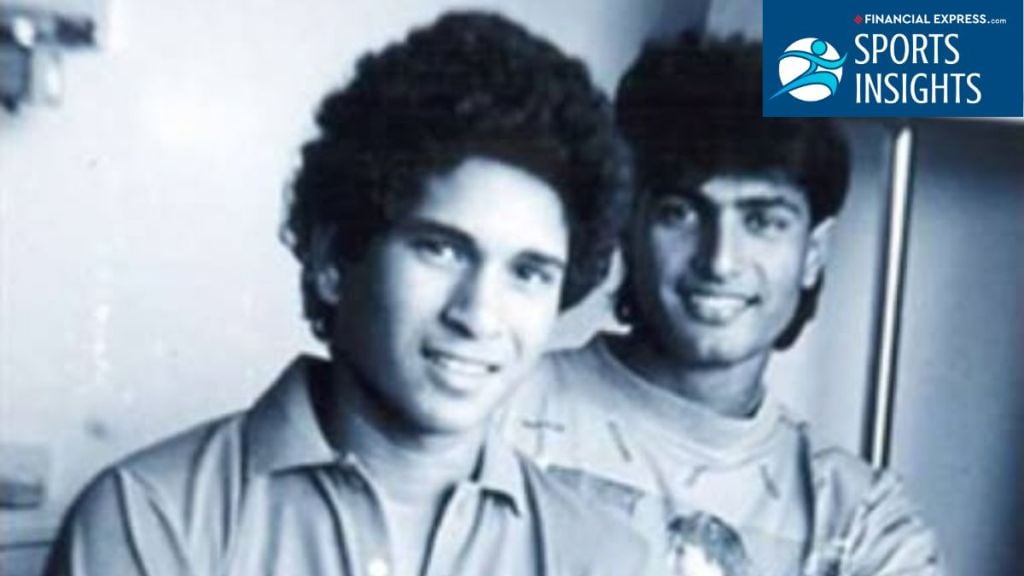The Other Debutant in Karachi
Salil Ankola was born in 1968 into a Konkani family from Ankola, a small coastal town in Karnataka. He grew up in Pune and represented Maharashtra in domestic cricket. At the age of 20, he made his first-class debut and immediately stood out. He scored 43 runs and took a hat-trick in his very first match.
By the end of that season, he had picked up 27 wickets, which earned him a place in India’s squad for the 1989 tour of Pakistan. That tour also saw the debut of two other names who would go on to become global stars, Sachin Tendulkar and Waqar Younis. Ankola played the first Test in Karachi and bowled with heart on an unhelpful pitch, finishing with two wickets. Unfortunately, an injury soon ruled him out of the rest of the series.
A Career That Deserved More
In December 1989, Ankola made his ODI debut at Gujranwala. The match was shortened due to bad light, but he made an immediate impression by hitting a six off the very first ball he faced. It remains one of the rarest starts to an international batting career.
He continued to work hard and made notable contributions whenever given a chance. One of his best performances came at Mohali in 1993, where he took three wickets for 33 runs against South Africa and helped India win. However, like many fast bowlers of that time, his body did not hold up well to the workload. Repeated injuries kept him in and out of the side.
Ankola was also part of India’s 1996 World Cup squad and played in the match against Sri Lanka at Feroz Shah Kotla. Though he did not take a wicket, he bowled economically at a time when most bowlers struggled against the Sri Lankan top order. But chances never came regularly, and within a year, his international career came to a close.
His final appearance for India came in early 1997 against South Africa. He was just 29. Soon after, a bone tumour in his leg forced him to retire from all forms of cricket. His first-class numbers, however, spoke of his quality with 181 wickets at an average of 25.3 and a strike rate of 47.8, including eight five-wicket hauls and consistent spells for Maharashtra and Mumbai. In a time when India struggled to produce genuine fast bowlers, Ankola stood out for his pace and commitment in domestic cricket.
From the Field to the Screen
For many, retirement at 29 would have meant an ending. For Salil Ankola, life after cricket did not stop; it simply took a different turn. In the same year that he retired, he found a new direction in acting. His first break on television came with the Zee TV show Chahat Aur Nafrat. Soon after, he appeared in Kora Kagaz on Star Plus, which made him familiar to viewers across India.
In the years that followed, Ankola acted in many well-known serials and films including Kurukshetra, Pitaah, and Chura Liya Hai Tumne. He carried himself with ease on screen and looked comfortable in front of the camera. The shift from cricket to acting worked well for him, something that very few Indian cricketers had managed to do successfully.
Acting gave Ankola both stability and recognition. For some time, it looked like he had found a new balance in life. Even when television work slowed down later, he stayed involved with the industry and picked projects that matched his experience and presence.
A Quiet Return to Cricket
Even while he was acting, cricket never really left him. Cricket had been a big part of his life, and it always stayed with him.
In 2020, Ankola made his way back into the game in a different role when he took charge as the chief selector of the Mumbai Cricket Association. The role meant a great deal to him. It was a sign the sport still needed his experience and believed in his judgment. Then, in 2023, he was named to India’s national selection committee.
Around the same time, he also took up commentary work. Talking about cricket on air often reminded him of his own days on the field.
What His Journey Shows Us
When Sachin Tendulkar lifted Indian cricket to the heavens, Ankola’s story slipped into the shadows. Yet both began that same day in Karachi. Both shared one thing in common, they never stopped believing in their journey and Ankola’s journey reminds us that a person’s second innings can often be just as meaningful as the first.
Salil Ankola’s story may not have the records or trophies that make headlines, but it never lost its meaning. His years as a fast bowler, his second innings in acting, and his return to the sport as a selector and commentator together reflect the story of a man who kept moving forward and never let one phase of life define him.

